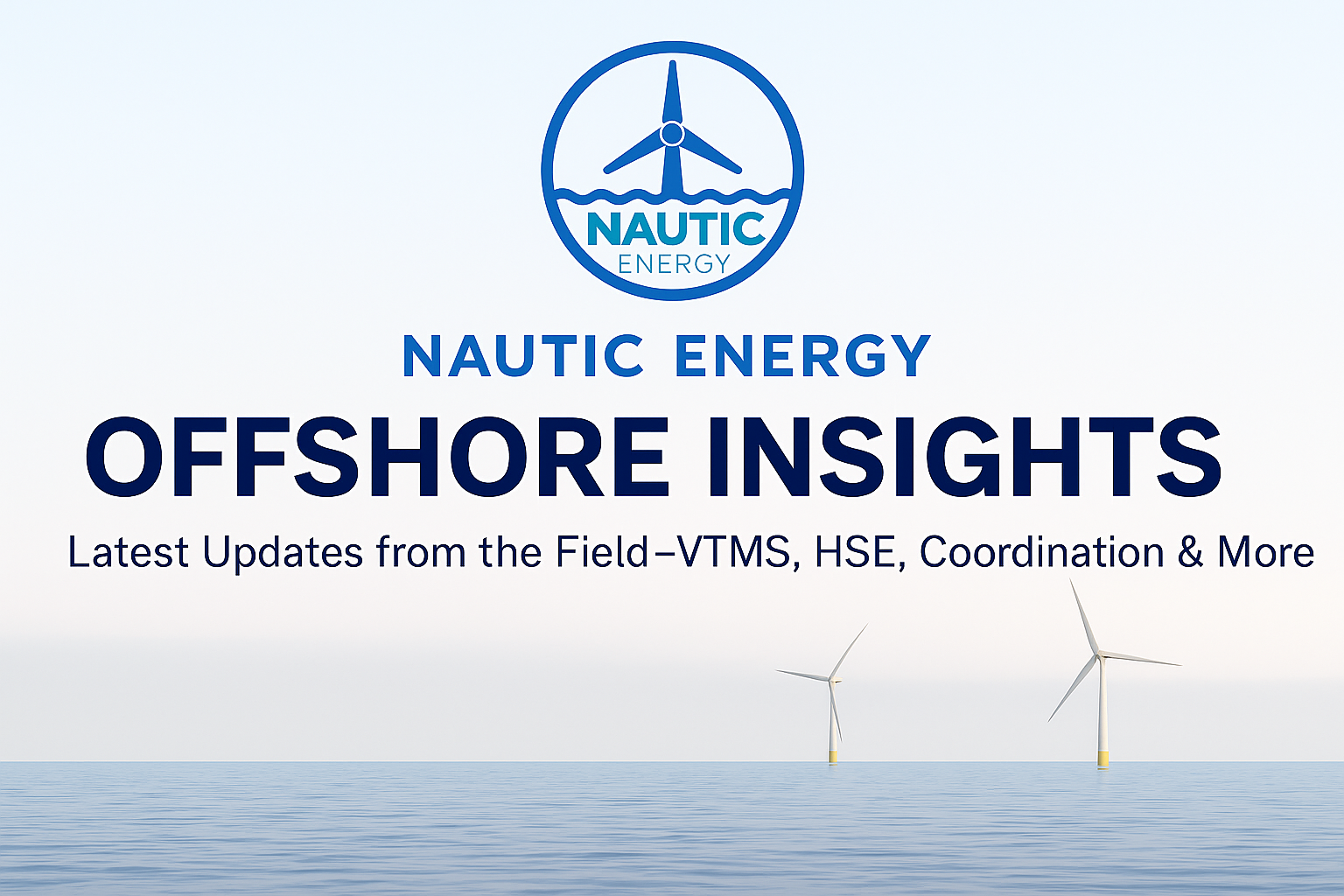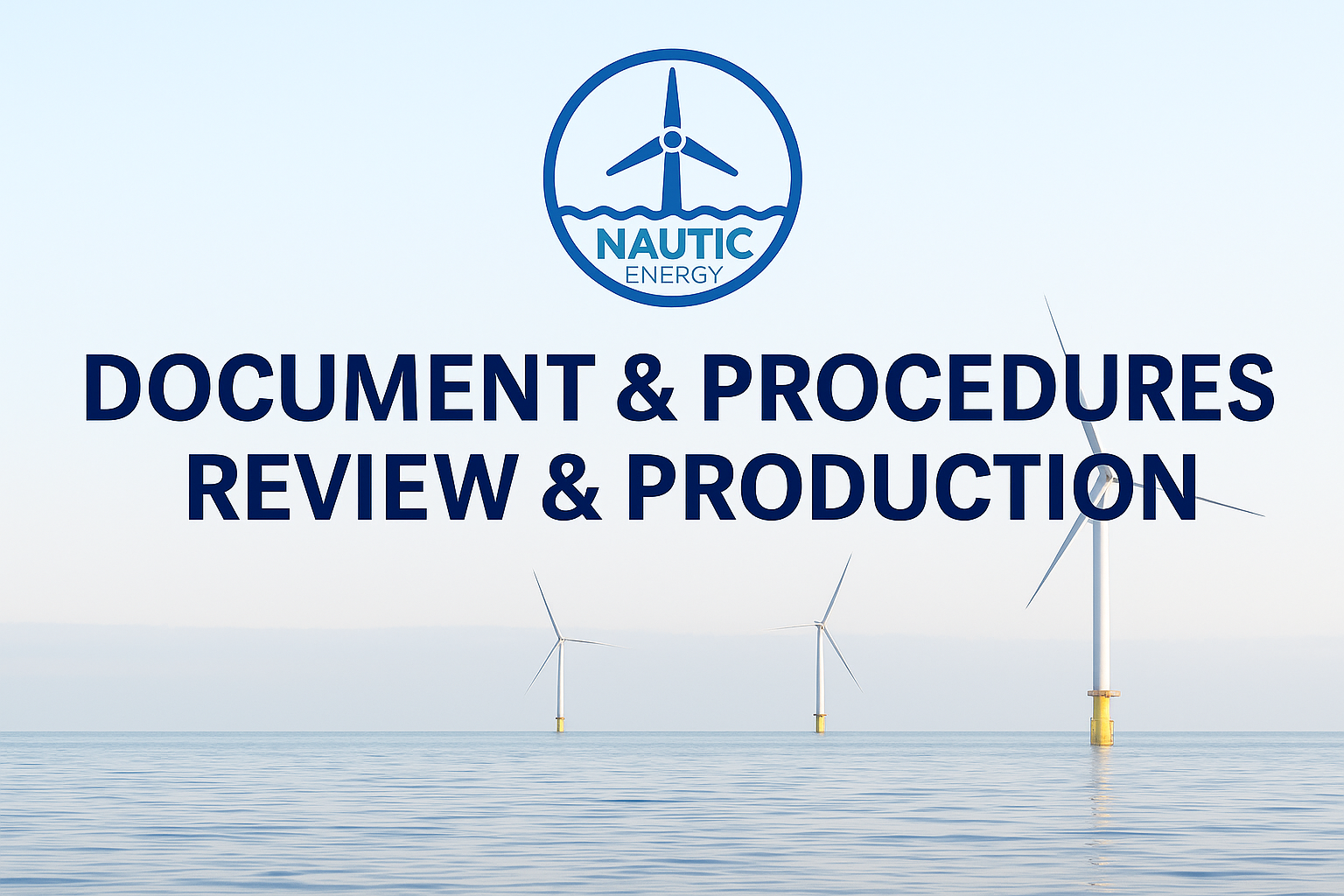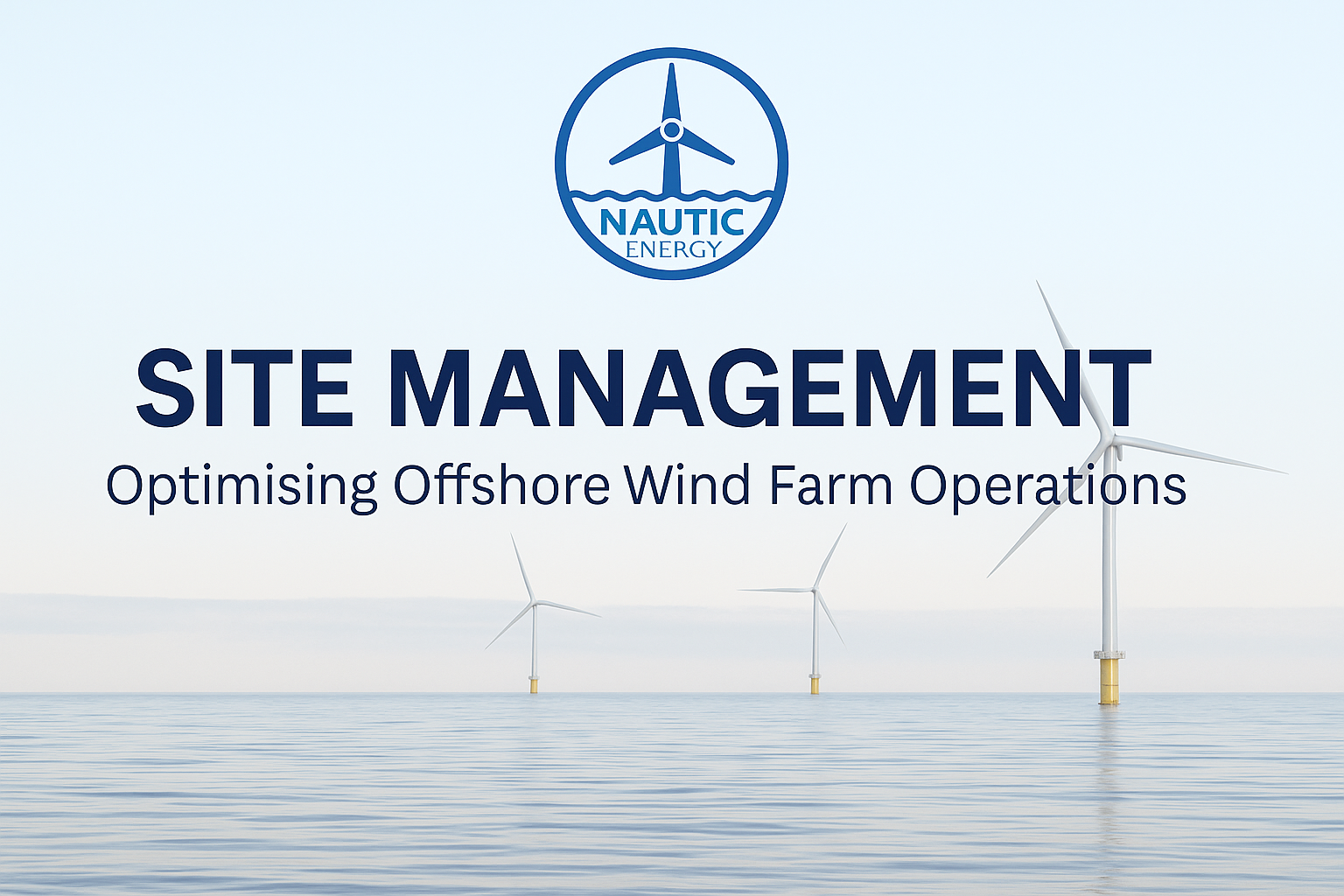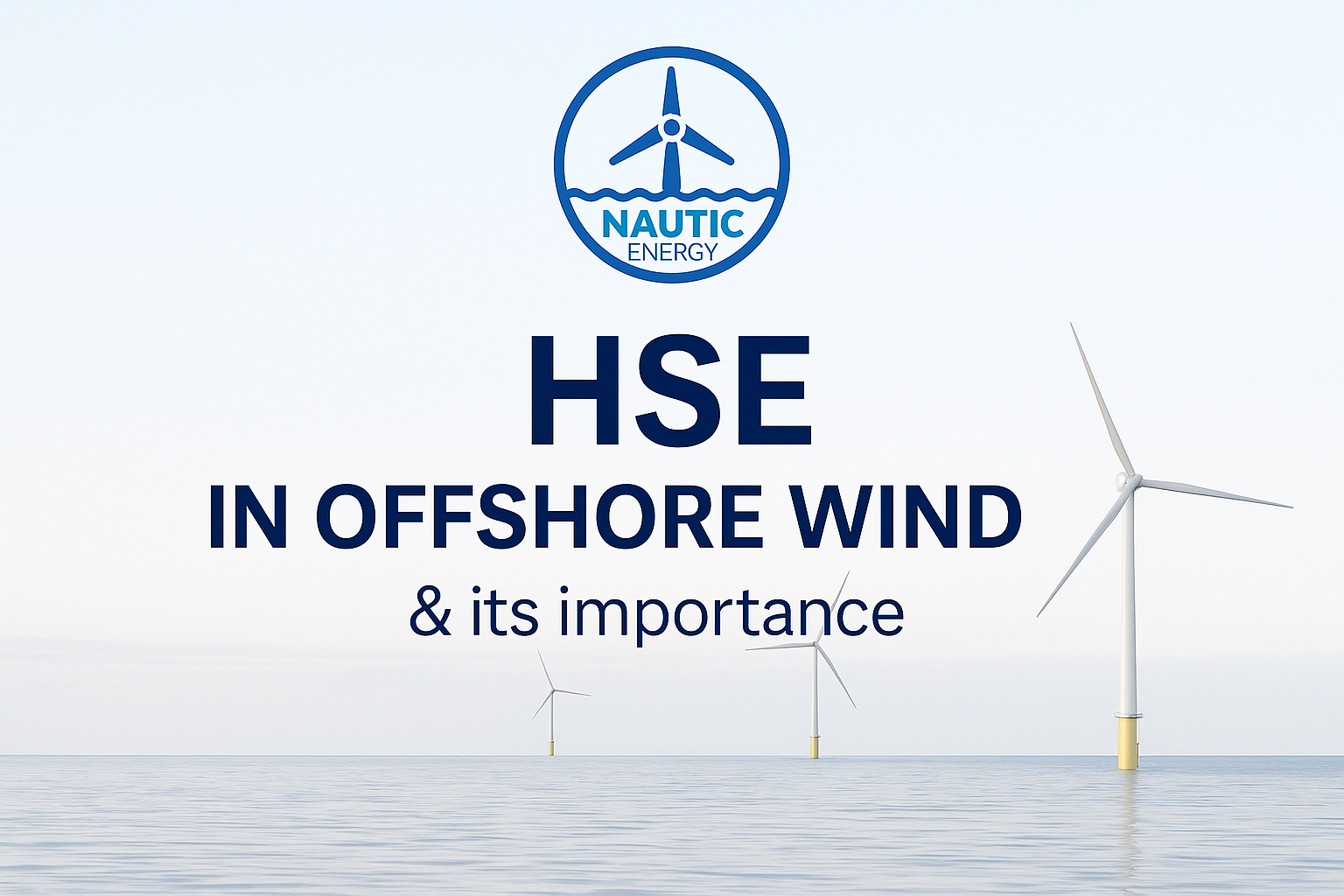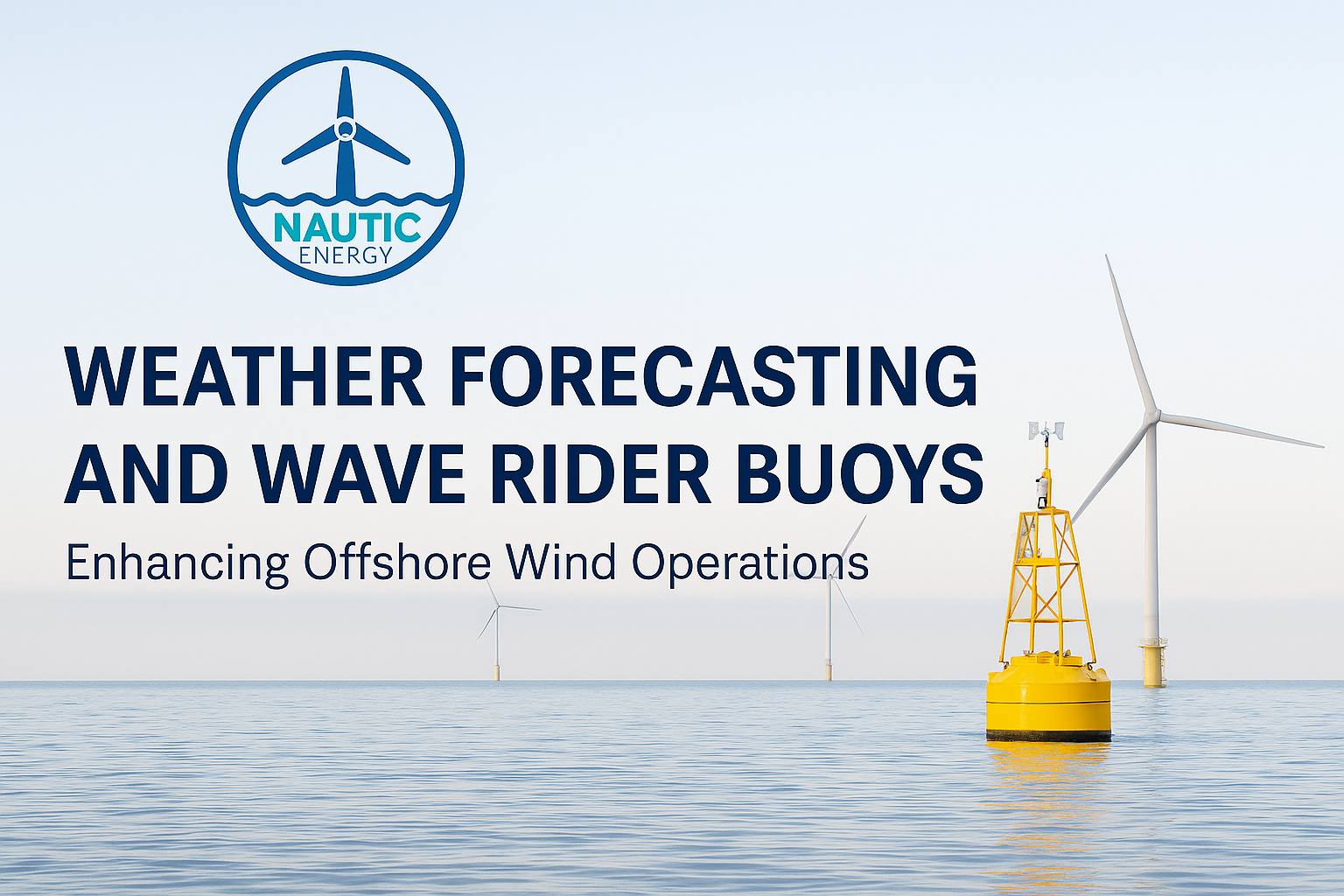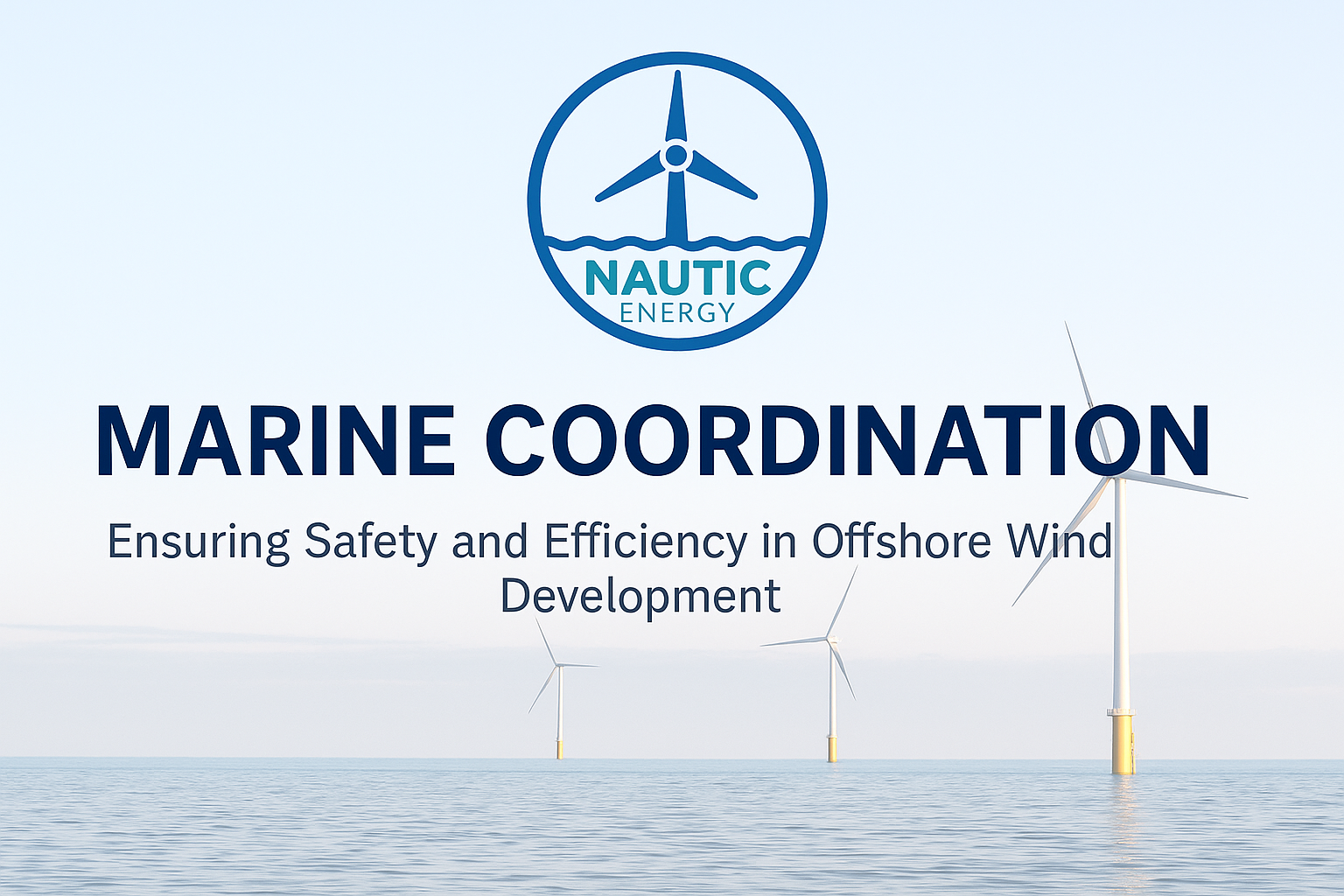Document & Procedure Management
Document & Procedure Management:
Building the Backbone of Offshore Wind Safety and Efficiency
In the offshore wind industry, success hinges not only on turbines, vessels, and cables — but also on paperwork. From HSE documentation to marine operational procedures, the offshore environment demands a structured, consistent, and compliant document management process.
At Nautic Energy, we specialise in the production, review, and management of offshore wind project documentation, ensuring your operations are safe, auditable, and aligned with international and client-specific standards. Well-crafted documents are more than just paperwork — they are tools that enable clarity, reduce risk, and drive performance.
Why Documentation Matters Offshore
Offshore wind projects bring together dozens of contractors, national regulations, and rapidly changing operations — often in high-risk environments.
Without the right documentation, teams may lack:
Clear roles and responsibilities
Standard operating procedures (SOPs)
Emergency response clarity
Certification tracking
Permit-to-work (PTW) control
Gaps in documentation can lead to delays, misunderstandings, and non-compliance — all of which can escalate project costs or create safety hazards.
Our Document Services: From Development to Deployment
At Nautic Energy, we provide tailored support across three key areas:
📘 1. Document Review
We assess and update client-provided documentation, ensuring alignment with:
IMCA, GWO, and ISO standards
Flag state and local regulations
SIMOPS coordination requirements
Site-specific risk profiles
This includes HSE plans, ERP (Emergency Response Plans), transfer procedures, and contractor bridging documents.
🖊️ 2. Document Production
Need project documents built from scratch? We produce:
Marine Coordination Procedures
Crew transfer & access protocols
Permit-to-Work (PTW) systems
Marine Safety Management Systems (SMS)
Toolbox Talk templates and TBT packs
These are developed collaboratively with your team and tailored to your operations, vessel types, and jurisdiction.
🔄 3. Ongoing Updates & Version Control
Project phases evolve — and so should your documents. We maintain:
Version control logs
Change request processes
Stakeholder approval workflows
Everything is tracked, timestamped, and stored securely for easy retrieval during audits or HSE reviews.
Documentation That Supports Real-World Operations
Our background in marine coordination, site management, and offshore HSE means we write documents that are not only compliant, but also practical.
We don’t deliver boilerplate templates — we build operational documents that:
Make sense to vessel crews and contractors
Enable faster onboarding and safer workflows
Reduce grey areas and interpretation risks
Stand up to client, classification society, and third-party audits
🌍 Trusted Offshore, Globally
With experience across UK, European, and Taiwanese offshore wind markets, Nautic Energy understands the nuances of regional compliance — and we tailor documents accordingly.
Whether you're preparing for a new-build campaign, contractor mobilisation, or HSE audit, our documentation support gives you confidence and clarity at sea.
💬 Final Thoughts
Offshore wind is fast-paced and high-stakes — and your documents should reflect that. From emergency plans to procedural workflows, robust documentation is how operational intent becomes consistent, safe action.
At Nautic Energy, we build documents that work in real-world offshore environments — not just boardrooms.
Need help reviewing or building your offshore wind project documents?
Contact us here or explore our Marine Services for more ways we support operational excellence.
Site Management in Offshore Wind
Site Management in Offshore Wind: Coordinating Complexity, Delivering Results
Offshore wind farms are among the most complex infrastructure projects in the world — vast marine construction zones with hundreds of people, dozens of contractors, and constantly shifting logistics. In this high-risk, high-value environment, effective Site Management is not optional — it’s mandaotry.
At Nautic Energy, we provide comprehensive Site Management services that keep offshore wind projects under control, compliant, and on course — from mobilisation ports. Marine coordination centre to offshore installation sites. Our team ensures every phase is delivered safely, efficiently, and to the highest industry standards.
What Is Site Management?
Site Management is the real-time coordination of all activities at an offshore wind project site — both onshore and offshore. It connects the moving parts: vessels, teams, tools, vessels, schedules, and safety systems, ensuring work proceeds smoothly and safely.
Whether at a fabrication / pre-assembly yard or offshore installation site, our Site Management ensures the project remains audit-ready, stakeholder-aligned, and performance-driven at every step.
Why It Matters
Offshore wind construction and commissioning involve:
Multiple subcontractors operating simultaneously (SIMOPS)
Harsh marine conditions that affect access and productivity
Cross-disciplinary interfaces (civil, electrical, marine, logistics)
Stringent HSE, environmental, and quality standards
Without structured Site Management, projects face:
Delays and cost overruns
Safety breaches or non-conformances
Poor communication and reporting inefficiencies
Coordination breakdowns between port and offshore operations
In short, Site Management is what keeps complexity under control — and projects on track.
Our Site Management Capabilities
At Nautic Energy, our embedded Site team act as the operational hub for each campaign, ensuring seamless coordination between marine operations, construction teams, and project management offices.
✅ 1. Contractor Coordination
Oversee and align multiple contractors across scopes
Manage cross-discipline interfaces (marine, civil, electrical)
Lead daily coordination and progress meetings
✅ 2. HSE Oversight
Implement, enforce and monitor site-specific HSE plans
Conduct toolbox talks, safety briefings, and drills
Ensure compliance of all personnel and equipment
✅ 3. Logistics & Vessel Scheduling
Coordinate vessel movements and operations
Track personnel movement, training, and certification
✅ 4. Site Documentation & Reporting
Maintain site logs, reports, and permit-to-work systems
Deliver clear KPI-based reporting to clients and stakeholders
Prepare for audits, inspections, and compliance checks
✅ 5. Interface Management
Liaise with Marine Coordination and onshore project teams
Integrate weather forecasts and Vessle limitations into daily planning
Enable real-time decision-making through clear communication
Our Global Experience
Nautic Energy has delivered Site Management and operational support for major offshore wind projects across:
United Kingdom
Europe
Taiwan and the Asia-Pacific region
Our team combines hands-on operational expertise with a deep understanding of developer, EPC, and contractor perspectives, ensuring balanced and effective project delivery — no matter the environment or project stage.
💬 Final Thoughts
In the offshore wind industry, Site Management is the glue that holds together people, processes, and performance. Done right, it keeps your project safe, efficient, and fully aligned with stakeholder expectations.
At Nautic Energy, we don’t just manage sites — we enable execution, safeguard standards, and empower clients with clarity and control.
Looking for experienced Site Management support?
Contact Nautic Energy today or explore our full range of Site Management Services to learn how we can support your next offshore campaign.
HSE in Offshore Wind
🛡️HSE in Offshore Wind: Protecting People, Assets & the Environment
In the rapidly expanding offshore wind sector, ensuring safety and sustainability is as important as producing clean energy. With hundreds of personnel, high-risk operations, and extreme environments, the offshore wind industry demands a robust Health, Safety, and Environment (HSE) framework.
At Nautic Energy, HSE isn’t just a regulatory checkbox — it’s a core value woven into every stage of our projects. From risk assessments and documentation to onsite safety management and audits, we provide clients with experienced support that helps meet industry standards and protects what matters most.
Why HSE Is Essential in Offshore Wind
The offshore environment is inherently hazardous. Working at sea involves unpredictable weather, moving vessels, high voltages, rotating machinery, and simultaneous operations (SIMOPS). Without structured safety protocols and environmental oversight, risks to human life, marine ecosystems, and project performance increase dramatically.
The objectives of HSE in offshore wind are to:
✅ Protect offshore personnel from injury or harm
✅ Ensure safe and compliant vessel and turbine operations
✅ Prevent environmental incidents such as fuel spills or seabed disruption
✅ Satisfy international, regional, and client-specific regulatory frameworks
Core Functions of HSE in Offshore Projects
At Nautic Energy, our HSE services are structured to support both developers and contractors throughout the full lifecycle of an offshore wind farm. Our HSE functions include:
📝 1. Safety Documentation & Procedures
We develop and review key project documents such as:
Emergency Response Plans (ERP)
HSE Plans & Bridging Documents
Toolbox Talks (TBTs) & Safety Briefings
Permit to Work (PTW) systems
These ensure clarity, consistency, and shared responsibilities across multi-contractor operations.
⚠️ 2. Risk Assessments & Method Statements (RAMS)
We assist in drafting, reviewing, and implementing RAMS to identify hazards and define control measures. This is a cornerstone of proactive incident prevention.
🚨 3. Incident Response & Management
Our team is trained to coordinate emergency responses at sea, including medical evacuations, oil spills, and collision incidents — all supported by compliant reporting procedures.
📊 4. Site Inspections & Audits
Routine site visits, vessel inspections, and compliance checks ensure that operations align with contractual, environmental, and statutory expectations.
🌍 5. Environmental Monitoring
We help clients mitigate their environmental impact, from noise pollution to waste management and marine fauna protection, in line with regional environmental directives.
🤝 Collaboration with Marine Coordination
Our HSE team works hand-in-hand with Marine Coordinators to control access to offshore assets, enforce exclusion zones, and ensure all personnel are certified, tracked, and working under valid permits. This synergy is crucial to safe SIMOPS execution and real-time response readiness.
The Nautic Energy Approach to HSE
What sets us apart?
Over 30 years of offshore wind experience across Asia and Europe
A team made up of Construction, Marine managers, and safety specialists
Strong knowledge of GWO, IMCA, IMO and ISO standards
Commitment to continuous improvement, learning, and reporting
💬 Final Thoughts
In offshore wind, HSE isn’t just about compliance — it’s about commitment. Commitment to the well-being of your workforce, to operational integrity and to protecting the marine environment we all rely on.
Whether you're commissioning new assets, managing a construction campaign or optimizing ongoing maintenance, Nautic Energy delivers the HSE insight and support that keeps your project moving forward — safely and sustainably.
Ready to strengthen your offshore HSE strategy?
Contact us today or visit our HSE Services Page to learn how we can support your next offshore campaign.
Weather Forecasting
Weather Forecasting & Wave Rider Buoys: Vital Tools in Offshore Wind Success
When it comes to offshore wind energy, the environment is as much a stakeholder as the developers, engineers, and contractors involved. Weather conditions at sea can change rapidly, and wave behavior can directly impact crew safety, equipment deployment, and project timelines. That’s why having reliable, high-resolution weather forecasting and real-time wave data from rider buoys is absolutely essential.
At Nautic Energy, we support offshore operations with a combination of expert meteorological forecasting and strategic deployment of Wave Rider Buoys — helping clients navigate both planning and real-time decision-making with confidence.
Why Offshore Weather Forecasting Matters
Weather plays a central role in every phase of an offshore wind farm’s lifecycle, from site surveys to turbine installation, and even through long-term operations and maintenance.
Here’s why accurate weather forecasts are mission-critical:
Safety First: Sudden weather changes can endanger personnel on Crew Transfer Vessels (CTVs) or jack-up barges. Reliable forecasts allow operations to be paused in advance.
Operational Efficiency: Knowing when weather windows will close or open means better planning of SIMOPS (simultaneous operations) and vessel scheduling.
Turbine Access Windows: Access to turbines is often limited by wind speed, sea state, and wave height. Forecasting helps maximise technician work hours and reduce downtime.
Compliance & Reporting: Documented forecasting and weather-related decisions support health, safety, and contractual compliance.
The Role of Wave Rider Buoys
Wave Rider Buoys are floating, instrumented platforms designed to measure:
Significant wave height (Hs)
Wave direction and period
Sea surface temperature
Wind speed and gusts
Current speed and direction (in some models)
These buoys are strategically positioned around wind farm sites to provide live, site-specific data that complements forecast models.
At Nautic Energy, our Wave Rider Buoy & Communications System allows:
Real-time access to wave and weather data
Remote health monitoring of buoy performance
Seamless data integration with Vessel Traffic Management Systems (VTMS) and site dashboards
Forecast + Data = Smarter Decisions
The combination of forecasting expertise and wave buoy instrumentation offers clients a 360° view of environmental risk:
🔄 Planning future lifts or crew transfers based on predicted sea states
🚧 Delaying SIMOPS when wind or wave thresholds are exceeded
📈 Analysing downtime or work limits after unexpected weather conditions
This empowers Marine Coordinators, Site Managers, and Offshore Construction Leads to make data-backed decisions that improve safety and save costs.
Trusted by Offshore Leaders
Nautic Energy’s forecasting and buoy deployment services are trusted by clients across the UK, Europe, and Taiwan. We understand the nuances of each regional weather system — from the dynamic Taiwan Strait to the harsh North Sea.
Whether it's typhoon tracking, real-time sea state alerts, or 7-day workability planning, our systems are built around your operational needs.
Final Thoughts 💬
In offshore wind, weather is the ultimate variable — and being able to anticipate, adapt, and act on weather intelligence is what separates reactive teams from proactive leaders.
With Nautic Energy's Weather Forecasting and Wave Rider Buoy Services, you gain the insight, tools, and support to keep your project safe, on time, and within scope — no matter what the skies bring.
Want to learn how our forecast services and wave monitoring systems can support your next project?
Contact us here or visit our Worldwide Weather Forecasting and Virtual Buoy & Communications page for more info.
IMCA & Survey Inspections
⚓ IMCA Inspections & Ship Surveying: Raising Standards in Offshore Wind
Offshore wind farms are built in some of the world’s most challenging and dynamic environments. Ensuring vessel reliability and operational safety is paramount — and that’s where IMCA Inspections and professional Ship Surveying come in.
At Nautic Energy, we provide independent, certified inspection and surveying services aligned with IMCA (International Marine Contractors Association) standards. Our goal: to help developers, owners, and operators meet strict safety, compliance, and performance requirements — while keeping projects efficient, accountable, and audit-ready.
What Are IMCA Inspections?
IMCA Inspections refer to internationally recognized vessel audit protocols designed to assess a ship's safety, compliance, and suitability for offshore work. Two of the most common types are:
eCMID (Common Marine Inspection Document)
A digital inspection covering vessel equipment, crew competency, safety management, and environmental controls.eMISW (Marine Inspection for Small Workboats)
Tailored to smaller vessels like Crew Transfer Vessels (CTVs), often used in wind farm operations. It evaluates safety readiness, documentation, and crew certification.
These inspections are vital to ensure that vessels supporting offshore wind farms — from survey craft to jack-ups — are operating at a high and consistent standard.
🚢 What Is Ship Surveying?
Ship surveying is the broader technical evaluation of a vessel’s structure, systems, and compliance status. Our surveyors assess everything from hull integrity to navigation equipment, and from firefighting systems to lifesaving appliances.
It plays a critical role during:
Charter party handovers
Pre-purchase inspections
Warranty assessments
Incident investigations
Dry dock planning and approvals
In offshore wind, these surveys support asset assurance and risk reduction at every phase of the project.
Why This Matters in Offshore Wind
Offshore wind farms involve multiple vessels, often working in parallel, in high-traffic zones and variable weather conditions. Without rigorous inspections and surveys:
Equipment failures increase
Safety protocols may be inconsistent
Certification lapses can delay operations
Regulatory breaches could lead to shutdowns or fines
By ensuring vessels meet IMCA and flag/state requirements, project leaders gain peace of mind — and insurers gain proof of due diligence.
Nautic Energy’s Inspection Services
As a trusted HSE and marine coordination partner, Nautic Energy offers:
Certified eCMID and eMISW inspections
Independent ship surveys for offshore and port-based assessments
IMCA-compliant reports ready for client and audit submission
Digital tracking of certificates and findings via cloud-based platforms
Practical recommendations based on real-world offshore experience
All inspections are carried out by trained surveyors with extensive wind industry backgrounds and a sharp eye for operational risk.
🌍 Supporting Offshore Wind Worldwide
Our inspection and survey teams have supported projects across Europe, the UK, and Taiwan, ensuring vessels of all classes meet stringent local and international standards.
Whether it’s a 30-metre CTV or a 130-metre cable-lay ship, our commitment to quality and safety remains the same.
💬 Final Thoughts
Reliable vessels are the backbone of offshore wind success. IMCA inspections and ship surveys provide the framework for safe, compliant, and efficient marine operations.
At Nautic Energy, we deliver inspection services that align with your project’s pace and priorities — ensuring that no vessel sets sail without certainty.
Need your vessels surveyed or inspected to IMCA standards?
Contact us today or visit our Marine Services page to learn how we support offshore wind developers from port to project site.
Marine Coordination Why It’s Critical to Safe & Efficient Operations
🌊 Marine Coordination in Offshore Wind: Why It’s Critical to Safe & Efficient Operations
As the offshore wind industry expands globally, the complexity of managing large-scale marine operations has grown in tandem. One of the most vital roles in ensuring project success — yet often behind the scenes — is Marine Coordination.
At Nautic Energy, Marine Coordination is not just a logistical role. It's the command centre of safety, oversight, and operational fluidity during construction, commissioning, and maintenance of offshore wind farms.
⚓ What Is Marine Coordination?
Marine Coordination refers to the centralised management and control of all offshore vessel and personnel movements on a wind farm project. It ensures every operation at sea — from transferring technicians to moving heavy-lift vessels — is executed safely, efficiently, and in full compliance with regulatory and client standards.
Why Is It Important?
Marine Coordination is essential because offshore projects involve:
Multiple contractors operating simultaneously (SIMOPS)
Vessels ranging from Crew Transfer Vessels (CTVs) to cable-laying ships
Harsh, dynamic weather conditions
Dozens, sometimes hundreds, of offshore personnel each day
Without proper coordination, the risks of accidents, delays, or costly downtime increase significantly.
Key Functions of a Marine Coordinator
At Nautic Energy, our Marine Coordinators carry out a range of critical tasks, including:
1. Vessel Traffic Management
We monitor and manage all vessel movements using advanced systems like SeaPlanner VTMS, ensuring traffic separation, safety zone enforcement, and optimized access to assets like turbines and substations.
2. Live Personnel Tracking
Every person offshore is tracked in real-time. Coordinators know who is on which vessel, which turbine, and for how long — an essential part of emergency response planning.
3. Radio Communications
We maintain constant communication across marine VHF, TETRA, or digital radio networks — ensuring real-time coordination with marine crews, transfer vessels, and site teams.
4. Safety and Compliance Oversight
We enforce exclusion zones around construction areas, confirm certifications for vessels and personnel, and maintain audit-ready records.
5. Emergency Response
In the event of an incident, the Marine Coordinator is the first to respond — triggering protocols, notifying stakeholders, and supporting recovery operations.
Tools of the Trade
We rely on integrated digital systems like SeaPlanner to provide:
Real-time vessel tracking
Permit-to-work management
Certificate validation
Weather data integration
Reporting and audit logs
These systems enhance both the safety and efficiency of the wind farm lifecycle.
Final Thoughts 💬
Marine Coordination is the heartbeat of offshore operations. When done well, it reduces downtime, improves safety outcomes, and ensures your project stays on course — regardless of the challenges at sea.
At Nautic Energy, we bring two decades of hands-on experience in offshore wind operations across the UK, Europe, and Asia. Our coordinators are former mariners, construction managers, and marine control specialists — combining technical know-how with situational awareness to keep projects running safely and smoothly.
Want to learn how Nautic Energy can support your next offshore campaign?
Contact us today or explore our Marine Services to learn more.
🌊 Marine Coordination in Offshore Wind: Why It’s Critical to Safe & Efficient Operations
As the offshore wind industry expands globally, the complexity of managing large-scale marine operations has grown in tandem. One of the most vital roles in ensuring project success — yet often behind the scenes — is Marine Coordination.
At Nautic Energy, Marine Coordination is not just a logistical role. It's the command centre of safety, oversight, and operational fluidity during construction, commissioning, and maintenance of offshore wind farms.
⚓ What Is Marine Coordination?
Marine Coordination refers to the centralised management and control of all offshore vessel and personnel movements on a wind farm project. It ensures every operation at sea — from transferring technicians to moving heavy-lift vessels — is executed safely, efficiently, and in full compliance with regulatory and client standards.
Why Is It Important?
Marine Coordination is essential because offshore projects involve:
Multiple contractors operating simultaneously (SIMOPS)
Vessels ranging from Crew Transfer Vessels (CTVs) to cable-laying ships
Harsh, dynamic weather conditions
Dozens, sometimes hundreds, of offshore personnel each day
Without proper coordination, the risks of accidents, delays, or costly downtime increase significantly.
Key Functions of a Marine Coordinator
At Nautic Energy, our Marine Coordinators carry out a range of critical tasks, including:
1. Vessel Traffic Management
We monitor and manage all vessel movements using advanced systems like SeaPlanner VTMS, ensuring traffic separation, safety zone enforcement, and optimized access to assets like turbines and substations.
2. Live Personnel Tracking
Every person offshore is tracked in real-time. Coordinators know who is on which vessel, which turbine, and for how long — an essential part of emergency response planning.
3. Radio Communications
We maintain constant communication across marine VHF, TETRA, or digital radio networks — ensuring real-time coordination with marine crews, transfer vessels, and site teams.
4. Safety and Compliance Oversight
We enforce exclusion zones around construction areas, confirm certifications for vessels and personnel, and maintain audit-ready records.
5. Emergency Response
In the event of an incident, the Marine Coordinator is the first to respond — triggering protocols, notifying stakeholders, and supporting recovery operations.
Tools of the Trade
We rely on integrated digital systems like SeaPlanner to provide:
Real-time vessel tracking
Permit-to-work management
Certificate validation
Weather data integration
Reporting and audit logs
These systems enhance both the safety and efficiency of the wind farm lifecycle.
Final Thoughts 💬
Marine Coordination is the heartbeat of offshore operations. When done well, it reduces downtime, improves safety outcomes, and ensures your project stays on course — regardless of the challenges at sea.
At Nautic Energy, we bring two decades of hands-on experience in offshore wind operations across the UK, Europe, and Asia. Our coordinators are former mariners, construction managers, and marine control specialists — combining technical know-how with situational awareness to keep projects running safely and smoothly.
Want to learn how Nautic Energy can support your next offshore campaign?
Contact us today or explore our Marine Services to learn more.
What is VTMS and Why It Matters for Offshore Wind Projects
In the complex world of offshore wind energy, real-time situational awareness is critical to safety and efficiency. That’s where VTMS — Vessel Traffic Management System — plays a vital role.
At Nautic Energy, we utilize advanced VTMS platforms such as SeaPlanner to provide a live overview of vessel movements, personnel transfers, and operations across wind farm zones. These systems allow us to proactively manage risks and coordinate all offshore activity with precision.
The Role of VTMS in Offshore Wind Farm Operations
In the increasingly complex and high-traffic environment of offshore wind energy, real-time situational awareness isn’t just beneficial — it’s essential. From overlapping construction schedules to simultaneous operations (SIMOPS) involving multiple vessels and contractors, maintaining order, safety, and efficiency requires a system that can monitor, track, and manage dynamic marine activity.
That’s where VTMS — Vessel Traffic Management Systems — come in. Much like air traffic control for offshore environments, VTMS provides a central platform through which marine coordination teams can maintain complete visibility and control over site activity.
How VTMS Enhances Offshore Wind Site Management
At Nautic Energy, we deploy advanced VTMS platforms such as SeaPlanner to deliver a live, data-rich overview of all vessel activity, personnel transfers, and safety protocols across the wind farm footprint. The system enables us to not only track vessels and personnel, but also to anticipate and deconflict operations, reducing downtime and preventing incidents before they occur.
Key functional areas include:
🔹 Live Vessel Tracking & Geofencing
All vessels working on the project are registered by MMSI and tracked in real time. This includes:
Monitoring speed, heading, and position
Assigning permissions or alerts based on proximity to critical infrastructure
Automatic geofence alarms if a vessel breaches a designated safety zone (e.g., around jack-up barges or cable lay areas)
🔹 Safety Zone Enforcement
VTMS platforms automatically enforce exclusion and buffer zones:
Alarms are triggered if unauthorized vessels enter active construction zones (typically 500m safety radius)
Marine Coordinators are instantly alerted to intervene, contact masters, or escalate to client representatives
🔹 SIMOPS Management
With multiple operations happening concurrently — such as turbine installation, cable laying, and crew transfers — the VTMS allows us to:
Visualize all activity layers and vessel types in a unified interface
Schedule and pre-approve activities to avoid overlap
Coordinate with contractors to mitigate operational conflict and risk
🔹 Personnel Tracking & Movement Control
All offshore workers are registered within the VTMS, including:
Certification verification (e.g., GWO compliance)
Site induction tracking
Live visibility of who is on what vessel, en-route, or on a turbine
Enables controlled transfers and automated headcounts in case of emergency
Benefits to Developers and Contractors
By integrating VTMS as a core part of project delivery, Nautic Energy ensures:
Reduced downtime due to better vessel utilization and scheduling
Improved safety compliance across all marine operations
Streamlined communication between marine coordination, vessels, and site teams
Full audit trails for vessel activity and personnel movements — critical for client reporting and regulatory inspections
Why Choose Nautic Energy?
With over 20 years of offshore wind experience and a growing presence in Taiwan and the wider APAC region, Nautic Energy brings hands-on expertise with major VTMS platforms and international marine standards. We don’t just operate the system — we strategically integrate it into your site management plan, delivering smarter coordination, safer projects, and more confident offshore execution.
Looking for a partner with proven VTMS capability and regional experience?
Contact Nautic Energy to discuss your offshore coordination needs.

